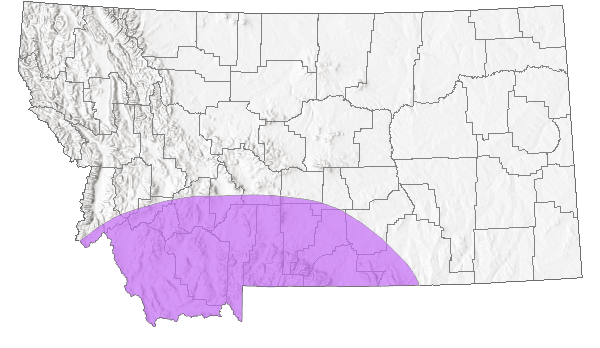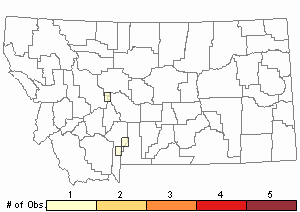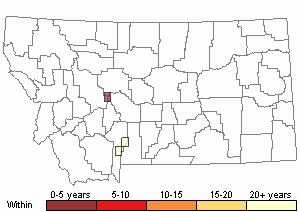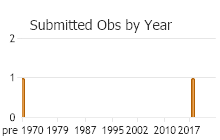View in other NatureServe Network Field Guides
NatureServe
Montana
Utah
Wyoming
Idaho
Wisconsin
British Columbia
South Carolina
Yukon
California
New York
Coral-winged Grasshopper - Pardalophora apiculata
General Description
The following is taken from Hebard (1928), Brooks (1958), Helfer (1971), Otte (1984), Vickery and Kevan (1985), Bland (2003), Capinera et al. (2004), Brust et al. (2008), and Scott (2010). A large, ashy-brown to gray grasshopper with limited large dark spots on the tegmina (forewings) and the anterior base being entirely dark. When the wings are folded, the dorsal field has broad converging pale stripes. In some individuals the entire surface can be pale. The dorsal surface of the pronotum (thorax) is flat, granulated with a few small tubercles. The median carina (ridge) is low, distinct, and incised forward of the middle by the main sulcus (groove), the lateral margins often form distinct ridges. The hind wing disk is rosy to red, bordered with a black band and a long anterior spur extending nearly to the wing base. The inner face of the hind femur is yellow to orangish with two to three black bands and a black crescent at the knee. The hind tibia is yellow.
Communicative behavior/Crepitation*
This species does not crepitate but does perform flight displays in which the males flash their red hindwings, making about 2 displays in 30 seconds, for a distance of 8-10 feet and two feet above the ground (Otte 1970, 1984, and Vickery and Kevan 1985).
*Crepitation is the sound produced by grasshoppers making a clicking or snapping noise with their wings when in flight, during courtship, territorial encounters or being disturbed.
Phenology
This species overwinters in the 4th or 5th nymphal stage from eggs laid and hatched the previous year in late-summer and autumn. Adults appear in late May to July, when they disappear (Otte 1984, Vickery and Kevan 1985, and the BugGuide website).
Diagnostic Characteristics
The following comes from Hebard (1928), Brooks (1958), Helfer (1971), Otte (1984), Vickery and Kevan (1985), Bland (2003), Capinera et al. (2004), Brust et al. (2008), and Scott (2010). The body length to end of forewings is 32-42 mm for males, and for females 42-58 mm. The wings extend beyond the abdominal tip (the specimen pictured in this field guide is a female with eggs causing the abdomen to extend beyond the tegmina tip).
The Coral-winged Grasshopper can be confused with its congener,
Haldeman’s Grasshopper (
Pardalophora haldemanii), but that species is heavily spotted, whereas the basal area of the tegmina of
P. apiculata is entirely dark and the presence of black markings on the inner face of the hind femur easily separate the two species (Otte 1984).
Species Range
Montana Range
Range Descriptions

 Native
Native
Range Comments
The Coral-winged Grasshopper occurs from the far north of the Northwest Territories, across all the Canadian Provinces to New Brunswick, southward to Tennessee and western North Carolina. From east to west, the northern half of the East Coast to Montana, eastern Wyoming, and northeastern Colorado. In Montana, it has been reported for 3 counties (Otte 1984, Vickery and Kevan 1985, Capinera et al. 2004, and Scott 2010).
Observations in Montana Natural Heritage Program Database
Number of Observations: 6
(Click on the following maps and charts to see full sized version)
Map Help and Descriptions
Relative Density

Recency



 (Observations spanning multiple months or years are excluded from time charts)
(Observations spanning multiple months or years are excluded from time charts)
Habitat
This species inhabits pine and spruce forest clearings and park lands, preferably on sites with sandy soils (Brooks 1958, Otte 1984, and Vickery and Kevan 1985).
Food Habits
Little is known but seems to prefer grasses and sedges in the genera’s of Agropyron, Poa, and Carex plus, some forbs such as dandelion (Brooks 1958, and Brust et al. 2008).
Reproductive Characteristics
During courtship, males perform two types of stridulation: Type 1 stridulation consists of 1 to 4 strokes with both femora. Type 2 consists of a rapid series of strokes with one femur, producing stridulatory bursts of 4 to 18 pulses. Sound is sometimes produced on both up and down strokes. When several bursts occur in succession, the left and right femurs are sometimes alternated to produce the sound. The signals are given by the stationary male before approaching the female. An attracted female spreads her hind femora away from her abdomen, lowers them to the ground, vibrates and turns her abdomen toward the courting male, allowing him to mount and copulate. Copulation last from 1-2 hours; upon completion, they depart. No further observations have been reported in the literature relative to oviposition, egg pods, etc. The nymphs pass through 5 instar stages before reaching the adult stage. This species has a life cycle of two years, passing the first winter in the egg stage, and the second winter in the 4th or 5th nymphal stage (Otte 1984, and Vickery and Kevan 1985).
Stewardship Responsibility
References
- Literature Cited AboveLegend:
 View Online Publication
View Online Publication Bland, R.G. 2003. The Orthoptera of Michigan—Biology, Keys, and Descriptions of Grasshoppers, Katydids, and Crickets. East Lansing, MI: Michigan State University Extension, Bulletin E-2815. 221 p.
Bland, R.G. 2003. The Orthoptera of Michigan—Biology, Keys, and Descriptions of Grasshoppers, Katydids, and Crickets. East Lansing, MI: Michigan State University Extension, Bulletin E-2815. 221 p. Brooks, A.R. 1958. Acridoidea of Southern Alberta, Saskatchewan, and Manitoba (Orthoptera). The Canadian Entomologist (Supplement 9) 90:5-92.
Brooks, A.R. 1958. Acridoidea of Southern Alberta, Saskatchewan, and Manitoba (Orthoptera). The Canadian Entomologist (Supplement 9) 90:5-92. Brust, M.L, W.W. Hoback, and R.J. Wright. 2008. The Grasshoppers of Nebraska. Lincoln, NB: University of Nebraska Extension Service, APHIS.
Brust, M.L, W.W. Hoback, and R.J. Wright. 2008. The Grasshoppers of Nebraska. Lincoln, NB: University of Nebraska Extension Service, APHIS. BugGuide. 2003-2022. Identification, Images, & Information for Insects, Spiders & their Kin for the United States & Canada. Accessed 6 January 2022. https://bugguide.net/
BugGuide. 2003-2022. Identification, Images, & Information for Insects, Spiders & their Kin for the United States & Canada. Accessed 6 January 2022. https://bugguide.net/ Capinera, J.L., R.D. Scott, and T.J. Walker. 2004. Field Guide to Grasshoppers, Katydids, and Crickets of the United States. Ithaca, NY. Cornell University Press.
Capinera, J.L., R.D. Scott, and T.J. Walker. 2004. Field Guide to Grasshoppers, Katydids, and Crickets of the United States. Ithaca, NY. Cornell University Press. Hebard, M. 1928. The Orthoptera of Montana. Proceedings of the Academy of Natural Sciences of Philadelphia, Vol. 80:211-306.
Hebard, M. 1928. The Orthoptera of Montana. Proceedings of the Academy of Natural Sciences of Philadelphia, Vol. 80:211-306. Helfer, J.R. 1971. How to Know the Grasshoppers, Crickets, Cockroaches, and Their Allies. Revised edition (out of print), Mineola, NY: Dover Publications.
Helfer, J.R. 1971. How to Know the Grasshoppers, Crickets, Cockroaches, and Their Allies. Revised edition (out of print), Mineola, NY: Dover Publications. Otte, Daniel. 1970. A comparative study of communicative behavior in grasshoppers. Miscellaneous Publications, Museum of Zoology, No. 141. Ann Arbor, MI: University of Michigan.
Otte, Daniel. 1970. A comparative study of communicative behavior in grasshoppers. Miscellaneous Publications, Museum of Zoology, No. 141. Ann Arbor, MI: University of Michigan. Otte, Daniel. 1984. The North American Grasshoppers Volume II. Acrididae (Oedipodinae). Harvard University Press. 366 pp.
Otte, Daniel. 1984. The North American Grasshoppers Volume II. Acrididae (Oedipodinae). Harvard University Press. 366 pp. Scott, R.D. 2010. Montana Grasshoppers, Katydids, and Crickets A Pictorial Field Guide to the Orthoptera. MagpieMTGraphics, Billings, MT.
Scott, R.D. 2010. Montana Grasshoppers, Katydids, and Crickets A Pictorial Field Guide to the Orthoptera. MagpieMTGraphics, Billings, MT. Vickery, V. R. and D. K. M. Kevan. 1985. The grasshopper, crickets, and related insects of Canada and adjacent regions. Biosystematics Research Institute, Ottawa, Ontario. Publication Number 1777. 918 pp.
Vickery, V. R. and D. K. M. Kevan. 1985. The grasshopper, crickets, and related insects of Canada and adjacent regions. Biosystematics Research Institute, Ottawa, Ontario. Publication Number 1777. 918 pp.
- Additional ReferencesLegend:
 View Online Publication
View Online Publication
Do you know of a citation we're missing? Kirk, K. and C.R. Bomar. 2005. Guide to the grasshoppers of Wisconsin. Madison, WI: Wisconsin Department of Natural Resources, Bureau of Integrated Science Services PUB-SS-1008. 154 p.
Kirk, K. and C.R. Bomar. 2005. Guide to the grasshoppers of Wisconsin. Madison, WI: Wisconsin Department of Natural Resources, Bureau of Integrated Science Services PUB-SS-1008. 154 p. McDaniel, B. 1987. Grasshoppers of South Dakota. Brookings, SD: South Dakota Agricultural Experiment Station, Bulletin TB 89.
McDaniel, B. 1987. Grasshoppers of South Dakota. Brookings, SD: South Dakota Agricultural Experiment Station, Bulletin TB 89.
- Web Search Engines for Articles on "Coral-winged Grasshopper"
- Additional Sources of Information Related to "Insects"





